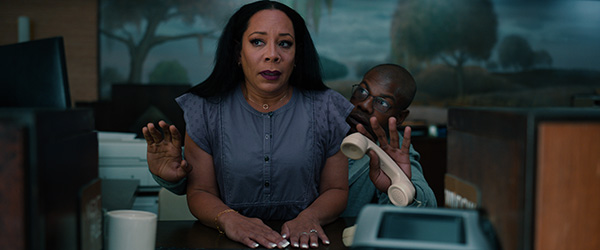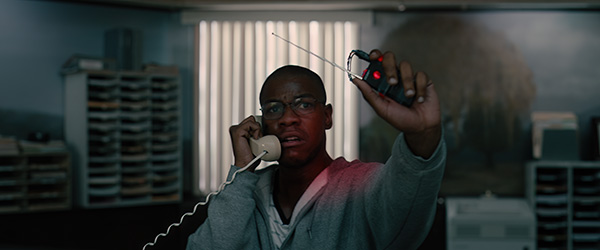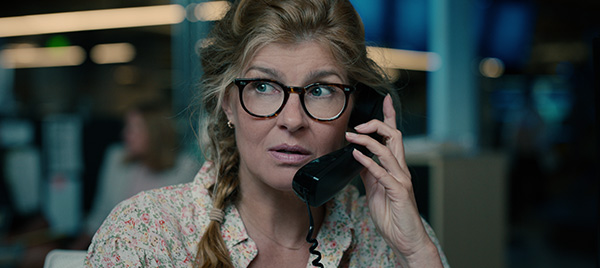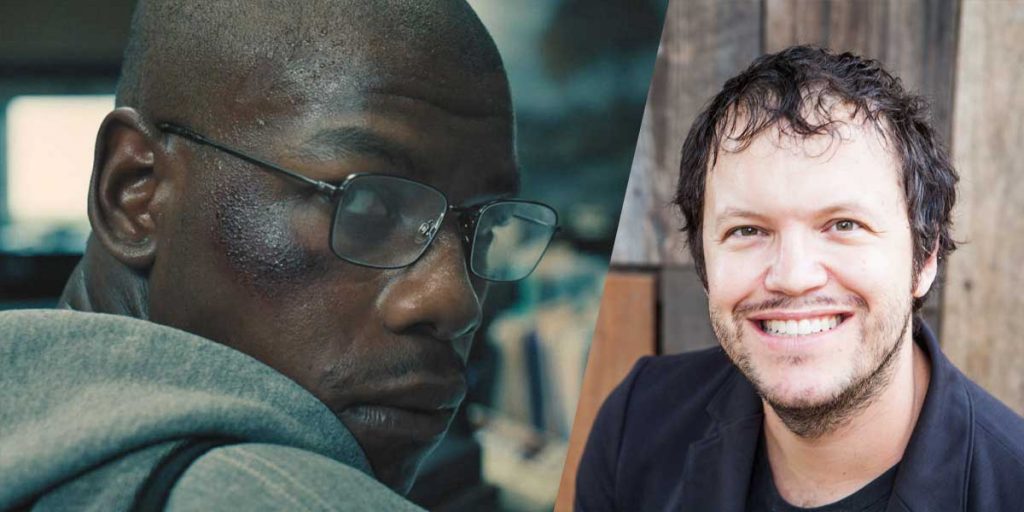Breaking ‘s editor Chris Witt tells us about the film’s origins, the importance of honesty in storytelling, crafting a real-time experience, and more.
Based on 2021 article “They Didn’t Have to Kill Him: The Death of Lance Corporal Brian Easley” and directed by Abi Damaris Corbin (The Suitcase), Breaking is the story of a U.S. marine war vet named Brian Brown-Easley (John Boyega) who struggles to reintegrate back into civilian life as a result of his disability check failing to materialize from Veterans Affairs. Living in a cheap motel in Atlanta and separated from his wife and child, Brian soon finds himself on the brink of homelessness, and the only solution that comes to his mind is walking into a Wells Fargo Bank and telling the bank’s employees that he’s “got a bomb.“ What ensues is a series of phone calls that alert various authorities of what’s happening in the bank, but Brian makes it clear from the beginning that he’s not there for the money: all he wants is to tell his story, and we are there to listen. But the same cannot be said of many of the authorities Brian speaks to in the film: it takes a drastic act for him to be noticed, but he’s still perceived as a threat rather than a victim, which makes the matter of his disability check even less of a priority to the people in charge.
Thanks to superb performances from John Boyega, the late Michael K. Williams, and the film’s exceptional cast (including Shame‘s Nicole Beharie, Orange Is the New Black‘s Selenis Leyva, Little Fires Everywhere‘s Olivia Washington and Promising Young Woman‘s Connie Britton), our eyes are glued to the screen as we follow Brian’s journey. But the way the film was shot and edited also plays a huge role in its success, as it enables us to experience Breaking‘s events in real time with Brian, which makes for an incredibly immersive, deeply affecting experience that will stay with you for a long time.
In the occasion of Breaking‘s World Premiere at the 2022 Sundance Film Festival, where the film won U.S. Dramatic Special Jury Award for Best Ensemble Cast, we’ve spoken to editor Chris Witt. Here’s what he told us on how the project was born, the importance of honesty in storytelling, using “eye-trace” and restraint in editing, the film’s Ancient Greek tragedy structure, his approach to editing, the challenges of making the movie and more.

Breaking ‘s Origins and Chris Witt ‘s Editing Approach
How did you become involved in “Breaking”, and what drew you to it?
Chris Witt: While cutting her USC MFA thesis, The Suitcase, Abi Damaris Corbin and I bonded over a shared ethos of turning over every stone in finding the best story. From our earliest collaborations, we’ve always had a pact to keep digging and working until we are confident we have found the best movie. We also share similar tastes on pace and rhythm, and she also appreciates my speed and skill in crafting a solid assembly for us to build on.
Honest and nuanced performances are part of Abi’s secret sauce, so I was very excited to be invited to cut her first feature, Breaking. Another appealing aspect was that it was produced by the incredibly sharp producing team Ashley Levinson and Kevin Turen. I was also captivated by Brian Brown-Easley’s true story and the opportunity to help that story be heard. I was all in!
What was your approach to editing Breaking?
Chris Witt: The top consideration of everything we did on Breaking is to be honest in the storytelling. Not only in protecting the integrity of the real story, but we also cut out anything that felt false. Our brilliant cast made that task easier because they set the bar so high. After “cut” was called as I watched John Boyega in video village one day, I felt this unique urge to stand and applaud because his performance was so consistent and strong. It felt as though I was at a live Broadway performance.
Back in my bay watching the dailies, I occasionally found tears rolling down my face. It was very important to remember and protect those moments in the edit, because it’s so easy to lose perspective and try to cut out the very thing that once moved you as you go about tightening up the movie. The trick to cutting any scene is to identify where the emotion is felt and allow those takes to carry the weight of the scene. Balancing those raw emotional moments with the sharper, tense moments was the real challenge in the broad strokes of our pace and rhythm.
Something I really love about Breaking is that it takes place in very few locations and the characters are often static, either talking to each other or on the phone, but a lot of tension is conveyed through the way it was shot and edited.
How did you manage to establish tension so effectively through the film’s pacing?
Chris Witt: DP Doug Emmett and Abi crafted very deliberate camera setups and movements to keep the scenes fresh and tense. Paying special attention to “eye-trace” was my attempt to keep their design sharp and help the audience experience the movie as if in a dream so that the runtime would not be felt. You see, we are constantly using nonverbal cues including watching people’s eyes for an indication of where to weigh our attention. If a character is on screen right looking to the left, we’ll place some attention in the direction they are looking. On the other side of an edit, if the ideal focus is also on the left, our eyes won’t need to search the frame and thus the editing will feel natural and hopefully become invisible. Even a quick flick of the eyes can move the eye-trace so I try to leverage that power to guide you through each edit.
In addition, there were several opportunities in Breaking to align with the mental state of the characters through pace. There’s a great example I love when Estel is pleading with Brian that since he’s a family man, maybe he’ll let them go. I deliberately held on one shot of Brian holding back his answer as if burning a hole through her manipulation. I could feel my own blood pressure rise in anticipation of his next words. I hoped the audience could feel that intensity as well. Sometimes you identify an edit point that can work, but the key is to not take it if holding longer can create tension or an emotion for the audience. Restraint in the edit can be a great discipline to hone.

Breaking ‘s Real-Time Experience and Ancient Greek Tragedy Structure
It feels to me like, in Breaking, we experience things in real time, just like Brian does. There is one scene where Brian is in the bank and suddenly becomes afraid that there might be snipers outside, and we become aware of the cameras at the same time as he does, thanks to quick cuts between shots, and this really helps make the scene even more tense and gripping.
How did you manage to make the film so immersive and connected to the present through your editing?
Chris Witt: We often played with the idea of a real-time experience. Before the “Sniper Run,” as we called it, I took extra time to show his back and neck stiffen, and I’m allowing his experience to unfold without upcutting, but as his heart begins to race in his paranoia, I match with the pace of the edit— letting us see what he’s seeing, and thus feel as he feels.
Just like with the moment of Brian holding back with Estel, here was another opportunity to get into the mind of a character through the editing. If my rhythms ease you into a dream-like state, then I can sync you up with the character and you will acutely experience their emotion. It’s about moving the audience from an observational perspective into a subjective one with the character. Hopefully your heart was beating in time with Brian’s as he clocked all those security cameras!
I feel that the film’s pacing changes a lot at the end, and the ending is so affecting on an emotional level. Can you talk about your work editing the end scenes of the film?
Chris Witt: Somewhere along the way I discovered that incidentally our story lined up very well with the structure of the Ancient Greek tragedy that I learned years ago from Gina Austin-Fresh. We have a flawed, tragic hero willingly walking into a deadly situation he won’t be able to reverse. The movie also takes place in primarily one location over twenty-four hours, similar to a Greek tragedy. Most importantly, we were very aware of an opportunity for a deep catharsis at the end. Taking that into account, one thing we learned from the Greeks is that our word “obscene” comes from their idea of “off stage” or not showing the gore directly to the audience. For maximizing the emotional journey, we wanted to withhold the cathartic release till the very end. So even though we had shot plenty of grotesque images of Brian’s aftermath, we chose to not show those. Following the robots in and out of the bank, then pausing on the stained carpet, we created a sanctuary-like space for the audience to breathe and feel the very real loss of this man, Brian Brown-Easley.

The Challenges of Making Breaking and What’s Next for Chris Witt
What was the main challenge you encountered while working on the film?
Chris Witt: At every stage we were up against a wall for edit time. We initially planned to wrap by early July, but we lost our initial Brian being played by Jonathan Majors due to scheduling conflicts with Ant-Man 3. We were very fortunate to have John Boyega come on and brilliantly play Brian, but after all the delays of working in the era of Covid-19, we wrapped in late August with only weeks left until the Sundance deadline. Then when we gratefully got invited to premiere at Sundance, we still hadn’t shot our Atlanta unit, which we finally shot mid December. We then had to lock by New Years to finish in time for our premiere.
All that said, it was a challenge to find time to breathe and find fresh perspective along the way. Abi and I cut her short film under similar schedule constraints with only 14 days to do the bulk of that edit. So if there’s one thing I knew Abi and I could do as a team, it’s roll up our sleeves and make the very most of what we have to work with. We were also very grateful to have our sharp producing partners along the way help us see the movie in fresh perspectives. I think we did okay in the end!
Finally, what are your future projects?
Chris Witt: I’m actually on the hunt for the next feature to cut. But I do have another film releasing very soon: Jon Macdonald’s 1970s superhero flick The Hyperions starring Cary Elwes on Feb 25th, on demand March 1st. You can follow me on Twitter and Instagram @chriswitt.
Breaking premiered at the Sundance Film Festival (with the title 892) on January 21, 2022 and is now available to watch in the US on digital and on demand. The film will be released in UK cinemas on March 27, 2023.

